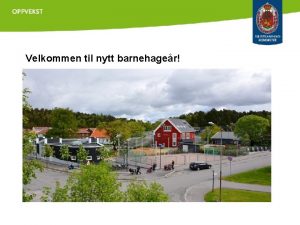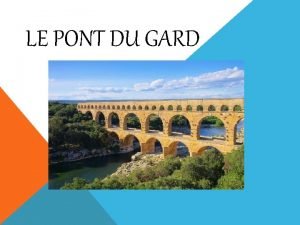Roman Architecture Pont du Gard The Pont du







- Slides: 7

Roman Architecture

Pont du Gard The Pont du Gard (literally bridge of the Gard ) is an aqueduct in the South of France constructed by the Roman Empire. It was originally part of a 50 km (31 miles) canal supplying fresh water to the Roman city of Nimes. The aqueduct was constructed entirely without the use of mortar. The aqueduct’s stones – some of which weigh up to 6 tons – were precisely cut to fit perfectly together eliminating the need for mortar. From the Middle Ages to the 18 th century, the aqueduct was used as a conventional bridge to facilitate foot traffic across the river.

Pantheon One of the best preserved Roman buildings, The Pantheon was built in 126 AD as a temple for all the Roman gods. The temple has served as a Roman Catholic Church since the 7 th century. The Pantheon consists of a large circular portico with three ranks of huge granite Corinthian columns. The portico opens into a rotunda which is topped with a concrete dome with a central opening: the oculus. Almost two thousand years after it was built, the Pantheon’s dome is still the largest unreinforced concrete dome in the world.

Colloseum The Colosseum in Rome is the largest and most famous monument in the Roman world. The construction of the amphitheater was started by emperor Vespasian of the Flavian dynasty in 72 AD and was finished by his son Titus in 80 AD. During the Colosseum’s opening ceremonies, spectacles were held for 100 days in which 5, 000 of animals and 2, 000 gladiators were killed. The Colosseum was capable of holding some 50, 000 spectators who could enter the building through no less than 80 entrances.

Hadrian’s Villa The villa was constructed at Tibur (modern- day Tivoli) as a retreat from Rome for Roman Emperor Hadrian during the second and third decades of the 2 nd century AD. After the conquest of Greece, the Romans were attracted to the luxuryand beauty of the Hellenistic art. Romans of wealth and/or rank started to copy Hellenistic palaces and ended with a passion for villas. Composed of over 30 buildings, the villa was created with the purpose of being Hadrian's retreat from Rome. Parts of the complex were named after well-known buildings and palaces that the emperor had visited on his travels around the empire. Among other distinctions, it is the greatest example of an Alexandrian garden and possibly one of the most spectacular Roman gardens.

Hadrian’s Wall • • By the time Hadrian became Emperor in 117 AD the Roman Empire had ceased to expand. Hadrian was concerned to consolidate his boundaries. He visited Britain in 122 AD, and ordered a wall to be built between the Solway Firth in the West and the River Tyne in the east "to separate Romans from Barbarians". Running for seventy-three miles, the Wall makes use of ridges and crags, particularly Whin Sill, and enables a good view to the north. Built by Roman troops, the Wall is estimated to have been between thirteen and fifteen feet high. It remains a potent symbol of Roman rule.

Maison Carrée • • • The Maison Carrée from the southern French town of Nîmes is a well-preserved example of a Roman Temple. Roman temples, are related to the Greek temple form in general design and use of the Classical orders. Originally built in 16 BCE by Marcus Vipsanius Agrippa – the close friend and confidant of Emperor Augustus – the building was dedicated to Agrippa’s sons Gaius Caesar and Lucius Caesar. La Maison Carrée was lucky to survive the fall of the Empire. This is mostly due to the fact that the building became a church in the fourth century. Through the ages La Maison Carrée has been used as a consul's house, stables and the town’s archive.












